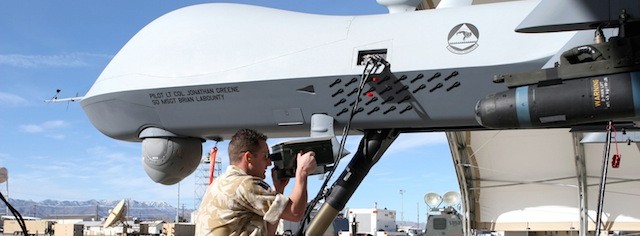The Portals are multimedia collections covering a variety of issues relating to drones. For more information and our full list of Portals, click here.
On Monday, September 17, 2001, President George W. Bush authorized lethal covert action against al-Qaeda. The next day, taking off from a base in Uzbekistan, the first armed Predator drone entered Afghan airspace in search of Osama bin Laden and his allies. In the 13 years since, drones have come to play a central role in U.S. counterterrorism strategy. Under the Obama administration, the CIA’s use of drones to conduct targeted killing operations greatly expanded, driven by a number of officials including John Brennan and Leon Panetta. In a 2009 speech to the Pacific Council on International Policy, Leon Panetta, then-Director of the CIA, said that when it comes to combating al-Qaeda, drones are “the only game in town.”
Drones have risen to prominence as a means by which the United States has confronted transnational terrorism. Consequently, these machines should be considered in the context of the resulting shifts in contemporary terrorism and counterterrorism strategy. This Portal examines the current paradigms of global terrorism and the strategy of targeted killing and provides a sampling of a few perspectives on these issues.
This Portal is curated by Dan Gettinger.

Part One: Global Terrorism
- “Understanding ISIS & its Dark Future” – Hoover Institution // Audio // 00:49:10 // October, 2015
“Hoover Working Group Member and Senior Fellow at the Brookings Institution Benjamin Wittes, along with authors William McCants (The ISIS Apocalypse: The History, Strategy, and Doomsday Vision of the Islamic State, September 2015) and Joby Warrick (Black Flags: The Rise of ISIS, September 2015) will discuss the long, arching threat of ISIS, its religious fervor, strategic calculation, and doomsday prophecy which have shaped the Islamic State’s past and foreshadows its dark future.” Follow with: “Joby Warrick, ‘Black Flags‘” at Politics & Prose.
- “The Rise of ISIS and Its Threat: David Kilcullen in Conversation with Robert Manne” – The Monthly // Video // 01:04:43 // May 27, 2015
“In this La Trobe University Ideas and Society session at the Wheeler Centre, David Kilcullen, author of the Quarterly Essay ‘Blood Year: Terror and the Islamic State’, and La Trobe University emeritus professor Robert Manne discuss the rise of ISIS and the threat it poses.” Follow with: “A Future of Coastal, Connected Cities” at TEDx Sydney.
- “The Terrorist’s Dilemma: Managing Violent Covert Organizations” – New America Foundation // Video // 01:27:59 // October 23, 2013
“Since 9/11, terrorism experts have sought to understand the way militant organizations work, often through the personalities of the men who lead them, but what about the groups themselves? How do these groups control their dispersed members? And do they use tools to monitor their operatives and enforce discipline that can be exploited by international governments?The New America Foundation’s National Security Studies Program hosted a conversation about how Dr. Shapiro’s findings inform our current understanding of al-Qaeda, as it increasingly operates as a network of powerful regional affiliates.”
- “Terrorist Behavior and Deradicalization” – The Loopcast // Audio // 00:45:13 // October 22, 2014
A fascinating analysis by Dr. John Horgan of the motivations of individuals who join terrorist organizations and commit terrorist acts. John Horgan is director of the University of Massachusetts Lowell’s Center for Terrorism and Security Studies. His latest article at Vice. Follow with: “Terrorist Financing and the Islamic State“ at The Loopcast and “Reality of the Islamic State’s Finances and Economy” at Jihadology.
- Kydd, Andrew H., and Barbara F. Walter. “The Strategies of Terrorism.” International Security 31.1 (2006): 49-80. Web. 27 Jan. 2015.
- Watts, Clint. “Inspired, Networked & Directed – The Muddled Jihad of ISIS & Al Qaeda Post Hebdo.” Weblog post. War on the Rocks, 12 Jan. 2015. Web. 27 Jan. 2015.

Part Two: Countering Terrorism
- “Military Operations Against ISIS” – House Armed Services Committee // Video // 03:28:34 // December 1, 2015
“Defense Secretary Ashton Carter and Joint Chiefs of Staff Chair General Joseph Dunford testified on U.S. military strategy to combat ISIS* militants in Iraq and Syria. Secretary Carter announced that the U.S. is expanding its special operations force in Iraq and Syria.”
- “Sir Richard Dearlove on Re-appraising the Counter-Terrorist Threat” – Royal United Services Institute // Video // 00:25:40 // July 7, 2014
“Former Director of MI6, Sir Richard Dearlove on Terrorism and National Security: Proportion or Distortion?” Sir Dearlove argues that the threat of terrorism has been somewhat exaggerated by government and the media. “Counterterrorism should no longer dominate our national security and planning,” he argues.
- “Why We Should Talk to Terrorists” – London School of Economics // Audio // 01:16:48 // March 5, 2015
“Jonathan Powell was chief of staff to Tony Blair and the chief British negotiator on Northern Ireland. In his new book Talking to Terrorists How to End Armed Conflicts, Jonathan concludes that every time we meet a new terrorist group we say we will never talk to terrorists but in the end we almost always do.”
- “Strategies for Countering Violent Extremists” – Carnegie Council for Ethics in International Affairs // Audio // 01:05:00 // November 24, 2014
“Jean-Paul Laborde, executive director of the UN Security Council Counter-Terrorism Committee Executive Directorate (CTED) discusses the role of the UN in countering terrorism worldwide.”
- “A Relentless Conversation About JSOC” – War On the Rocks // Audio // 00:48:38 // September 1, 2015
“Sean Naylor sat down to talk about his new book on Joint Special Operations Command, Relentless Strike, and the perils of reporting on the U.S. military’s most secretive organization.” Follow with: “After Words with Sean Naylor” at C-SPAN Book TV.
- Shapiro, Jacob N. and Siegel, David A.(2010) ‘Is this Paper Dangerous? Balancing Secrecy and Openness in Counterterrorism’, Security Studies, 19: 1, 66 — 98
- Walsh, James Igoe. The Effectiveness Of Drone Strikes In Counterinsurgency And Counterterrorism Campaigns. Strategic Studies Institute and U.S. Army War College Press, September, 2013.
- “The Gatekeepers” (Film)

Part Three: Targeted Killing
- “Drone Wars: The Future of Targeted Killings & Presidential Power” – University of Pennsylvania Law School // Video // 01:34:35 // May 16, 2013
“The University of Pennsylvania Law School hosted a high-level panel examining the critical legal and policy questions associated with drone warfare.” The speakers included Mark Mazzetti, author of The Way of the Knife: The CIA, a Secret Army, and a War at the Ends of the Earth; Claire Finkelstein, Professor of Law and Philosophy, Director for the Center for Ethics & Rule of Law, Penn Law; and Peter W. Singer, author of Wired for War: The Robotics Revolution and Conflict in the 21st Century.
- “Legacy of Drones” – Just Security // Video // 1:23:02 // October 27, 2015
National security law and policy blog Just Security hosted a panel discussion that addressed the implications of the targeted killing of U.S. citizen Anwar al-Awlaki and how the next U.S. president will use armed drones. The panel featured Scott Shane, a reporter at the New York Times and author of Objective Troy: A Terrorist, a President, and the Rise of Drones. Follow with: “How Anwar al Awlaki Became Objective Troy” at the Lawfare Podcast and Objective Troy: A Terrorist, a President, and the Rise of Drones.
- “Targeted Killings: A Modern Strategy of the State” – University of Oxford // Audio // 00:15:37 // May 24, 2011
A lecture by William F. Owen (Cranfield Defence and Security, UK Defence Academy) about Israeli targeted killings as part of Oxford University’s Changing Character of War program.
- Whitlock, Craig. “Plan for Hunting Terrorists Signals U.S. Intends to Keep Adding Names to Kill Lists.” The Washington Post. The Washington Post, 25 Oct. 2012. Web. 27 Jan. 2015.
- Masters, Jonathan. “Backgrounder on Targeted Killing.” Council on Foreign Relations, 23 May 2013. Web. 25 Jan. 2015.
- Michelle Lesh, Note, Public Committee Against Torture in Israel v. Government of Israel, 8 Melb. J. Int’l Law 373 (2007).
Lawfare Blog maintains a comprehensive Document Library on Targeted Killing.
For multimedia on the ethics and law of targeted killing, please visit our Laws of War Portal.
Bookshelf
Coll, Steve. Ghost Wars: The Secret History of the CIA, Afghanistan, and Bin Laden, from the Soviet Invasion to September 10, 2001. New York: Penguin, 2004. Print.
Hoffman, Bruce. Inside Terrorism. New York: Columbia UP, 1998. Print.
Mazzetti, Mark. The Way of the Knife: The CIA, a Secret Army, and a War at the Ends of the Earth. New York: Penguin, 2013. Print.
Naylor, Sean. Relentless Strike: The Secret History of Joint Special Operations Command. St. Martin’s Press, 2015. Print.
Shane, Scott. Objective Troy: A Terrorist, a President, and the Rise of Drones. Tim Duggan Books, 2015. Print.
Shapiro, Jacob N. The Terrorist’s Dilemma: Managing Violent Covert Organizations. Princeton: Princeton UP, 2013. Print.
Warrick, Joby. Black Flags: The Rise of ISIS. New York: Doubleday, 2015. Print.
Warrick, Joby. The Triple Agent: The Al-Qaeda Mole Who Infiltrated the CIA. New York: Doubleday, 2011. Print.
“Perspectives on Terrorism Journal” regularly publishes a comprehensive list of books on terrorism, counterterrorism, and intelligence studies.
Blogroll
Center for the Study of the Drone
- “The Presidential Candidates on Drones“
- “The Air Campaign Against ISIL“
- “Interview with Max Abrahms“
- “Diaries from the Shadows: Drones and Special Forces in the War on Terror“
- “Drones in the Abbottabad Documents“
- “The Disposition Matrix“
- “What do Bush Administration Officials Have to Say About Drones?“
- “Bard and West Point Debate Drones“
Resources
- Combating Terrorism Center at West Point
- Global Terrorism Database
- Office of the Director of National Intelligence
- Chicago Project on Security and Terrorism
- RAND Database of Worldwide Terrorism Incidents
- The New America Foundation and The Bureau of Investigative Journalism
Syllabi
- “Terrorism” – Stanford University // Thomas Hegghammer // Spring 2013
- “Terrorism, Civil War, and Non-State Threats” – Princeton University // Prof. Jacob N. Shapiro // Fall 2012
- “Terrorism and Counter Terrorism” – Tufts University // BG (Ret.) Russell Howard // Fall 2006
- “Warlords, Terrorists, and Militias: Theorizing on Violent Non-State Actors” – Massachusetts Institute of Technology // Prof. Fotini Christia // Spring 2009
Updated on January 11, 2016.
[includeme file=”tools/sympa/drones_sub.php”]
